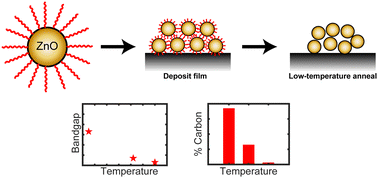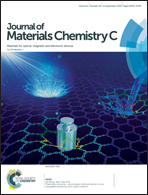Understanding quantum confinement and ligand removal in solution-based ZnO thin films from highly stable nanocrystal ink†
Abstract
We report a synthesis procedure for dodecanethiol capped wurtzite ZnO nanocrystals with an average diameter of 4 nm that are monodisperse, highly soluble, and shelf-stable for many months. Compared to previous ZnO ink recipes, we demonstrate improved particle solubility and excellent ink stability, resulting in ZnO nanocrystal inks that are optimized for printed electronics applications. The ZnO nanocrystal solution exhibits an absorption peak at 341 nm (3.63 eV), which represents a blue-shift of approximately 0.3 eV from the bulk ZnO bandgap (∼3.3 eV). This blue shift is consistent with previously reported models for an increased bandgap due to quantum confinement. We used variable-angle spectroscopic ellipsometry (VASE) to determine the optical properties of solution-processed thin films of ZnO nanocrystals, which provides valuable insight into the changes in film composition and morphology that occur during thermal annealing treatments ranging from 150–300 °C. The ZnO nanocrystals maintain their quantum confinement when deposited into a thin film, and the degree of quantum confinement is gradually reduced as the thermal annealing temperature increases. Using infrared absorption measurements (FTIR) and X-ray photoelectron spectroscopy (XPS), we show that the dodecanethiol ligands are removed from the ZnO films during annealing, resulting in a high-purity semiconductor film with very low carbon contamination. Furthermore, we show that annealing at 300 °C results in complete ligand removal with only a slight increase in grain size. Thin-film transistors (TFT) using ZnO nanocrystals as the channel material annealed at 300 °C show moderate mobility (∼0.002 cm2 V−1 s−1) and good on/off ratio >104. These results demonstrate the distinct advantages of colloidal nanocrystals for printed electronics applications: the composition and morphology of the solution-processed film can be carefully tuned by controlling the size and surface coating of the nanocrystals in the ink.



 Please wait while we load your content...
Please wait while we load your content...